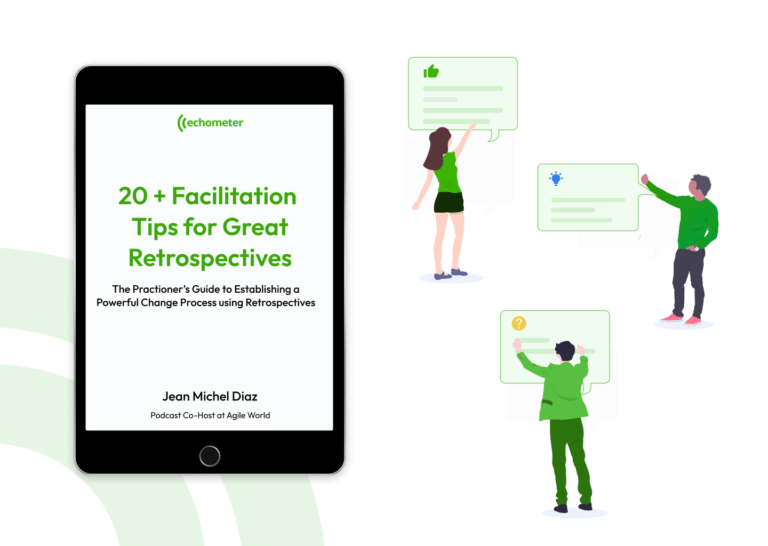Table of Contents
Experienced Scrum Masters and Agile Coaches often intuitively know how to moderate good retrospectives. Many inexperienced moderators, who may even prepare, conduct and moderate a retrospective in their role as a team member or team leader, ask themselves the question: How can I ensure that our retrospective is a success? What steps do I have to take when moderating?
I'm assuming that you're familiar with the basic process and phases of a retrospective . If not, check out the basics of retrospective once again in advance. Also could the 10 simple basic rules for an agile retrospective be helpful as a refresher.
Here is our step-by-step guide to conducting great retrospectives – for beginners as well as advanced facilitators:
Step 1: Set the Stage for a Great Retro
So that the chances of good retrospectives are not blocked in advance, make sure of the following things:
- All team members are invited and can participate. It's OK if a single person is missing, but if several team members are missing, it becomes problematic. Then you should reschedule the appointment if necessary.
- All team members know what a retrospective is. If that's not the case yet, share our article on "What is a retrospective" and make sure any questions from the team about the format are cleared.
Decide on a tool to conduct the retrospective. Of course we can recommend Echometer as a retro tool . However, you can find a broader overview in our article “14 retro tools in comparison".
Step 2: Choose the Right Check-in for Your Retro
The check-in or icebreaker creates the necessary atmosphere and framework for the retro. Everyone on the team answers a short question to warm up the atmosphere of the conversation.
Make sure that all team members arrive at the retro and can actively contribute at check-in.
Depending on the situation, you can choose a short or longer, serious or more playful check-in. It is only important that you do not skip the check-in.
If your team isn't actively participating in check-in, you may have chosen the wrong check-in format.
Here are a few Check-in formats for retrospectives for your inspiration.
Step 3: Create Space for Sharing Feedback
To give all team members enough peace to formulate their feedback, you should ensure that feedback is not directly shared out loud. Instead, you should give everyone the opportunity to formulate their feedback.
"Space" means both the period of time to formulate feedback and later when sharing: Each team member should have a similarly large time box (i.e. a previously agreed period of time) are available to present his/her feedback in the group.
In order for this to work, you, as the moderator, must of course prevent the team from going into the analysis or finding measures directly when the feedback is initially presented. That comes later in process of the retrospective.
Therefore, when presenting feedback, only allow questions of clarification and interrupt discussions early and decisively with the hint that there will be enough time for this later.
In particular, immediate criticism of feedback from the group can change the atmosphere and the psychological safety gets lasting damage. Here, again, it is your responsibility as a moderator to create awareness in the team.
Most Agile Coaches and Scrum Masters run in circles...
...fixing superficial symptoms. Time to use psychology to foster sustainable mindset change.
Step 4: Enough Time for Actions at the End of the Retro
It is challenging to formulate good measures. Of course, this becomes particularly difficult if you only have a little time left at the end of a retrospective. Accordingly, you should Timeboxing in the retrospective keep a close eye on things and plan enough time to define measures.
Are you wondering how to generally generate good action items in retrospectives? Then have a look here: More tips for better action items from retrospectives.
Step 5: Poll Retro Satisfaction & Measure ROTI
Nothing is more unsatisfying after a retrospective than not knowing how the participants perceived the retrospective. It doesn't have to be like this.
As a check-out of a retrospective, regularly ask about the satisfaction of your team.
In Echometer as a free tool for retrospectives this query then takes place automatically via the “Return On Time Invest” (ROTI). With the ROTI, team members can rate on a scale of 0 – 10 how well they think the time was invested.
All you have to do is ask the group in turn: What did you like about this retro and what should we do differently?
By asking this question at check-out, you show the team that they can actively help shape the retrospectives and that their opinion is important. Win win!
Step 6: Vary Your Retro Format
At the latest after the third retrospective with the same format, the team will report: Hm, the retrospectives will be one-sided.
But that's not a problem, because there are solutions. It is estimated that more than 20 million software developers worldwide use retrospectives and a corresponding number of retrospective formats have emerged. Accordingly, it is not a problem to bring variety into your retrospectives. Feel free to have a look here: 32 kickass retrospective ideas for beginners and professionals..
In the linked article you will find classics such as the Sailboat Retrospective, Keep Stop Start or Mad Sad Glad retro. But we also have a few so-called Health Check Retrospectives.
For example, you can see our Health Check Retrospective on the subject of team morale right here. Have a look at, you might even want to try them out with your team:
Note: This retrospective format asks for agreement with the given Health Check items on a scale.
- Appreciation: My colleagues appreciate my contribution to the team.
- Team Spirit: There is a trusting working atmosphere in our team.
- Transparency: Everyone in my team knows who is currently working on what.
- Recovery & Breaks: I have enough room for breaks in which I can draw new energy.
- Meeting culture: Our meetings are well structured, yet leave room for creativity and new ideas.
- Support: In my team, each team member passes on their individual knowledge and experience.
Do great retrospectives: With this eBook you''ll get it right!
Do you have the ambition to further develop your team through really good retrospectives? Then this eBook is for you:
eBook: 20+ Facilitation Tips for Great Retrospectives
In the eBook, I summarized all of my experience as a Scrum Master in 20 tips. And the feedback from my readers is pretty good – from both newbies and experienced Scrum Masters.










